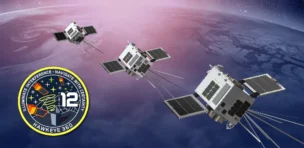MDA Space posted its Q1 2025 financial results yesterday, showing a strong quarter with revenues ($351M CAD/$252.3M), backlog ($4.1B CAD/$2.95B), and net income ($37.2M CAD/$26.7M) all up compared to the same period last year.
The question on everyone’s mind, however, is how the Canadian company will fare under the Trump administration’s tariffs. The White House also called for the cancellation of Gateway (the home base for MDA’s robotic arm) in the recent NASA budget proposal.
MDA’s answer: Nothing to see here.
Under the radar: MDA’s satellites are USMCA compliant. That means they will be exempt from the Trump administration’s tariffs on deliveries to the US, according to MDA CEO Mike Greenley.
The business’ total exposure to the US is already relatively minimal. 80% of the company’s customer base lies outside of the US, and only 25% of its supply chain comes from US manufacturers, Greenley said. While some costs may increase, the company said that contracts are progressing as usual with only slight changes in the attribution of tariff-specific responsibilities.
As for Gateway, MDA’s contract to supply the Canadarm3 is with the Canadian Space Agency, so NASA’s budget—whatever it may be once Congress has its say—has no direct impact on MDA’s work. Canadarm3 also garnered commercial interest (and other revenue streams) already, with contracts for its technology sold to Axiom Space.
Work on Canadarm3 will continue as planned, and if Gateway does go away for good, Greenley is confident the technology will find other applications in NASA’s planned lunar architecture.
Like a weed: The earnings call highlighted MDA’s recent growth in nearly every aspect of its business.
- In September, MDA began construction on a new 185,000 sq ft satellite manufacturing facility in Quebec, which should churn out two sats per day once completed.
- In February, MDA signed a $1.1BCAD ($768.1M) contract with Globalstar to build a constellation of 50+ MDA Aurora sats. This will be the third constellation contract MDA has won in as many years, and the second for Globalstar.
- In April, the company announced plans to acquire its Israel-based semiconductor supplier, Satixfy Communications, for $278M CAD ($193M). The deal is expected to close in the second half of this year.
With $376.3M CAD ($270.5M) in cash on hand, Greenely said MDA will continue to explore M&A opportunities to deepen its vertical integration and expand its business to more international markets.




